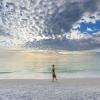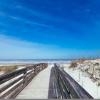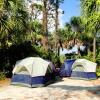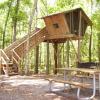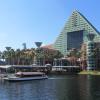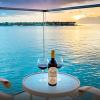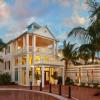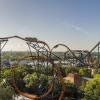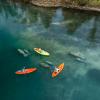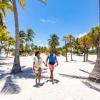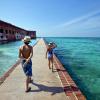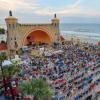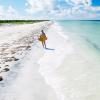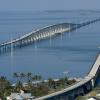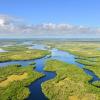By Janet K. Keeler
Want to experience Florida on a budget? Something, say, for under $30?
We’ve found 29 things to do around the state for $29 or less. Many of them are way less—how about free?
Whether you’re visiting Florida for the first time or have been here long enough to remember the first space shuttle mission, you’re sure to find something interesting —and inexpensive—on our list.
Southeast | Southwest | Central West | Central | Central East
Northeast | North Central | Northwest
Southeast
There’s no shortage of economical things to do from South Florida’s cosmopolitan Southern cities to the laid-back, come-as-you-are Florida Keys.
Sunset at Mallory Square, Key West
The sun sets every night, every year. And there may be no better place to catch a Florida sunset (or people-watch) than Mallory Square in Key West. The large square attracts crowds to the north end of the island to watch the nightly ritual and to be entertained by street performers. Don’t be surprised if you find yourself dancing to the salsa beat of a live band. It’s a free experience though you might want to buy a tropical cocktail or a psychic reading. Make sure to ask the reader when to book your return visit.
Wynwood Walls, Miami
The Wynwood Walls Arts District was once a tangle of lifeless warehouses and is now transformed into a hip, vibrant outdoor museum. Some 35 murals bring the warehouse walls to life with colorful images, many of which make social commentary. It’ll cost adults $12 (less for military personnel, seniors and kids) for self-guided tours and $20 for a guided tour. Within the art district are retail shops and galleries. And where there’s art, artists and cool people, there are interesting restaurants. Award-winning Zak the Baker is a tasty place to get a pastry and coffee. Or stop into Dasher & Crank for a scoop or two of ice dream dripping with tropical flavors.
Trolley and Boardwalk, Miami Beach
For more than 100 years, Miami Beach has drawn visitors from colder climates to celebrate tropical breezes and historic art deco architecture. The barrier island is divided into South Beach, Mid Beach and North Beach and, sure, you can walk the nine-mile island along mostly Ocean Drive, but the free Miami Beach Trolley will take you south to north, and back. You can hop off to explore the historic Fontainebleau Hotel or just to get a cocktail at one of the art deco hotel lounges. If you want to feel the breeze on your face and get some exercise, the Miami Beach Boardwalk is a seven-mile running, walking, in-line skating and (partial) biking path. The boardwalk runs between the beach and the back of the mostly hotels on the east side of Collins Avenue for about 40 blocks.
Feed the Tarpon at Robbie’s, Islamorada
Sometimes, you’ve just got to give in and do the touristy thing. Generations of visitors to the Florida Keys have stopped at Robbie’s in Islamorada to belly flop on the dock and hand-feed tarpon. The mammoth silver kings—they grow up to 8 feet and 250+ pounds—churn up the water as they surface to grab the fish food, which will set you back $5 a bucket. Admission is $2.50 and that will leave you enough to grab a $14 rum cocktail (or a much cheaper soda) at the marina bar.
Southwest
Natural Florida is on full display from Sarasota south to the Everglades, and there are plenty of experiences that are wallet friendly.
Clyde Butcher Big Cypress Gallery, Everglades
Put on the brakes as you cross the state on Tamiami Trail (U.S. 41) when you see the humble Big Cypress Gallery. Entry is free and inside you’ll get to see the work of legendary Florida photographer Clyde Butcher. Butcher is known as the Ansel Adams of Florida not only for his black-and-white artistry but also for his evocative depictions of the state’s dramatic landscape. For $29 or less, you can buy cards, calendars or maybe a book of photos. He also has a gallery in Venice. After spending some time studying Butcher’s work, you’ll see why he’s been enshrined in the Florida Artist Hall of Fame.
Monthly Antique Fair, Arcadia
The town of Arcadia is lined with antique shops. But on the fourth Saturday of every month, the streets themselves become stores as up to 100 vendors (more in winter than summer) set up intriguing wares for the open-air fair. Corningware bowls, boxes of mismatched silverware, vintage sunglasses, old roller skates, funky ashtrays and more, more, more. The center of town is on the National Register of Historic Places so besides perusing old treasures, you’ll get a glimpse of what a rural Florida town looked like way back when. The street fair is free and you’re likely to spy a must-have find for less than $29. When you’re ready for a rest and something sweet, head to Mary Margaret’s Tea and Biscuit for a cup of tea and a scone with clotted cream for less than $10.
Edison and Ford Winter Estates, Fort Myers
The winter homes of inventors Thomas Edison and the younger Henry Ford plus the lush gardens and working laboratories are lovingly maintained on 21 acres on the Caloosahatchee River. Tickets for self-guided tours are $25 for adults and less for teenagers and kids under 12. Children 5 and under get in free. Audio tours available via app (bring your earbuds!). You’ll get to tour the houses, gardens and a museum that includes antique automobiles. The laboratory of the Edison and Ford Winter Estates was the spot for research on rubber plants, which were of keen interest to automaker Ford.
Shark-Teeth Hunting, Venice
Did you know that sharks grow up to 25,000 teeth over their lives? Yes, and oodles of them litter the beach at Venice, vestiges of the time when Florida was underwater. It’s free to hunt for fossilized shark teeth on the beach and you’ll get more teeth if you have a sand scooper mostly used for hunting shells and a bag to store your collected bounty. Keep your head down and look for the shiny black bits that came from the skulls of sand, mako, bull or lemon sharks. And put some sunscreen on the back of your neck! Even when it’s cloudy you can get burned. And how nice is this? Parking is free. On your way out of town, stop for a cone at the Venice Avenue Creamery that’s been making ice cream since 1967.
Central West
The population of the Tampa Bay area continues to grow as does the number of affordable attractions that celebrate new and old Florida.
St Petersburg Shuffleboard Club, St. Petersburg
The courts of St. Petersburg’s Shuffleboard Club opened in 1924 and might just be drawing more people to the historic facility in its 100th year than ever before. The covered, wooden stands have been refurbished as has the clubhouse. It’s a popular spot for weddings and private parties, and on Friday nights the courts come alive with young people looking for a good time. From 7 to 10 p.m. on Fridays, $10 will get you equipment and lessons if you need them. This is not your great-grandmother’s pastime. Or maybe it is … with cocktails.
Sunday Brunch at Wat Temple, Tampa
Wat Mongkolratanaram of Florida—known locally as Wat Temple—is the place to be for brunch on Sunday mornings. From 9 a.m. to 1 p.m. the temple on the Palm River grounds buzzes with hungry visitors and volunteer cooks creating curry dishes, egg rolls, mango sticky rice, noodle soups and even empanadas. Repeat-eaters know to get there early because when the food is gone, the food is gone. They also know to bring cash (no cards accepted), and $29 can buy a lot, since items are between $5 and $9. After you get your food, head to a picnic table to enjoy the river view and a communal feast. No question you’ll meet someone interesting to talk with.
International Independent Showmen’s Museum, Riverview
There’s a rich history of the traveling circus in Florida with Ringling Bros. and Barnum & Bailey Circus spending winters in Sarasota and the community of circus sideshow performers who lived in Gibsonton, near Tampa. The Showmen’s Museum, which aims to “preserve the history of the American carnival,” is 54,000-square feet of pure nostalgia. It’s open from noon to 5 p.m. Saturday and Sundays and tickets are $12. Where else will you be able to see a 1903 Conderman Ferris Wheel and a 1950 American Beauty Herschell Kiddie Carousel? Plus the shoes the sideshow big man wore? For more history, head to the The Circus Museum on the grounds of the Ringling Museum in Sarasota, about 50 miles southwest.
Historic Sponge Boat Ride, Tarpon Springs
For just $10, you can take a 40-minute ride up the Anclote River to get a feel for how divers gathered natural sea sponges way back when. The fleet of sponge divers has dwindled and those still plying the trade don’t use the massive metal dive helmet modeled on the tour. The town of Tarpon Springs is a Greek enclave, thanks to immigrants who left Greece decades ago to harvest sponges. You’ll find the ticket booth for the St. Nicholas boat line on the river side of Dodecanese Boulevard. The other side of the street is lined with shops and restaurants. Stop into Hella’s Bakery for a Greek pastry and a coffee. Or maybe the house made hummus. Opa!
Crooked Can Brewery in Winter Garden is located on the edge of the quaint downtown.
-VISIT FLORIDA
Central
Central Florida is ground zero for theme parks but that doesn’t mean there aren’t other things to do that show a different—and less pricey—side of the Sunshine State.
Don Garlits Museum of Drag Racing, Ocala
People of a certain again will certainly remember Florida-native “Big Daddy” Don Garlits, who is considered the father of drag racing. In his 90s now, Garlits runs the Don Garlits Museum of Drag Racing on the property of his home. Visitors can view dozens of drag racing cars, including Garlits’s “swamp rats.” There’s lot of memorabilia—turns out Garlits is quite the collector besides being a legendary car racer. Admission is $22 and less for seniors, veterans, students and children. The facility is open 9 a.m. to 5 p.m. daily.
Swans Boat at Lake Eola, Orlando
In the shadow of downtown Orlando is lovely Lake Eola, a popular spot for city dwellers to shop at regular outdoor markets and walk the path (and their dogs) around it. There’s another way to enjoy the lake and that’s in a pedal-powered swan boat. Up to five people (weight limit 1,400 pounds) can pedal the avian boat and the cost of a 30-minute rental is $15. The lake is small so half-an-hour is plenty of time to pedal around and see the sights.
Crooked Can Brewery, Winter Garden
There are more than 400 craft beer breweries in Florida so recommending one is a tough job. But Crooked Can Brewery in Winter Garden has a lot in its favor. The brewery is located in the indoor Plant Street Market on the edge of the quaint downtown which bustles on the weekend with bicyclists riding the 22-mile West Orange Trail. The historic town is just 15 miles west of Orlando and on Lake Apopka. As for Crooked Can, grab some food from one of the market vendors (empanadas, BBQ and donuts, oh my) to pair with a Crooked Can Citrus Kicker or Cherry Cheeks brew. Enjoy it all in the taproom for way less than $29 and then take a free walk around town.
Lake Boat Excursion, Winter Park
A truly off-the-beaten-track excursion is the hourlong pontoon ride around the lakes and canals of Winter Park, just north of Orlando. Winter Park is well known for Rollins College, stately historic homes and notable restaurants like the Ravenous Pig and Chez Vincent. But a boat cruise shows you the town from entirely different vantage point. Narrated tours leave on the hour from 10 a.m to 4 p.m. daily and the boats cruise through seven lakes and three narrow canals with homes on either side. Tickets are $20 for adults; $10 for kids 2 to 11.
Central East
From Daytona Beach to Vero Beach and inland to historic Okechobee, this part of Florida shows off its unique and economical attractions.
Take a Ride on Daytona Beach
Unless you’ve been-there, done-that, driving a car (or golf cart or motorcycle) on the hard-packed sand of Daytona Beach sand is truly a Florida thing. It’s not surprising that in the shadow of the Daytona International Speedway the car is kin—even at the beach. You can only do 10 miles an hour (and no donuts!) and need to enter the beach at specified locations but it certainly is a fun way to experience Florida. Access to the beach is $20 per vehicle per day. Daytona Beach is open to motorized vehicles from 8 a.m. to sundown.
Wildlife Photography, Merritt Island National Wildlife Refuge
There are more than 350 bird species that have been identified at Merritt Island National Wildlife Refuge, across the Indian River from Titusville and just north of the John F. Kennedy Space Center. So it’s not surprising that birding and wildlife photography are popular in the refuge. The annual Christmas bird count draws people to the refuge to help assess the species and their numbers there. In 2024, the annual statewide Christmas bird count tallied more threatened Florida scrub-jays at Merritt Island than anywhere else in the state. And while there are plenty of people with binoculars looking for birds, there are also photographers capturing them with telephoto lenses. Visitors with smartphones can get some great shots of bald eagles and egrets. The bird population swells in the cooler months (November to April) when migrating birds flock to the refuge. It costs $10 a car to visit for the day.
Catching Waves at Sebastian Inlet
As much as Florida is known for its beautiful beaches, it doesn’t have a lot of street cred as a surfing destination. That doesn't mean there aren’t plenty of surfers on the lookout and some decent waves too. You’ll find lots of them at Sebastian Inlet State Park on the long barrier island of Brevard County. The park entry fee is $8 per car per day and once you find a place to perch, you can watch the surfers at the epicenter of Florida competitive surfing. In fact, it’s the place where local due and world-champion surfer Kelly Slater learned to ride. What’s the secret to the surfable waves here? On the north side of the inlet, a jetty amplifies the waves and they grow taller over the shallow sandbars. If you want to know what the waves are looking like, check out Surf Guru’s daily surf report and live web cam.
Watch a Rocket Launch, Cocoa Beach
The Kennedy Space Center Visitor Complex has a great viewing area to watch rockets roar into space but the $75 ticket price is too steep for our $29 or less budget. No worries, the sky is big and the rockets go high so you can witness the power-packed spectacle from all over the area. What you need is the launch schedule to plan a trip accordingly. Set out your beach chairs on Cocoa Beach to the south of the John F. Kennedy Space Center and get ready to rumble–or at least for the ground to move. A first-time launch watcher is sometimes surprised how much the ground shakes at takeoff. If you want the full narration, tune into live Nasa TV on your smartphone for the countdown and other pertinent information. Want something else free to do? Head to the Ron Jon Surf Shop mothership afterward and marvel at the racks and racks of swimsuits. It’s like a retail amusement park. The Florida Surf Museum is embedded in the Ron Jon complex and a $2 donation is suggested for entry.
The Kingsley Plantation is part of the 46,000 acre Timucuan Ecological and Historic Preserve, east of Jacksonville.
-Carrie McLaren
Northeast
Florida biggest city in landmass and population—Jacksonville— rubs up against iconic landmarks and tales of the real first Thanksgiving.
St. Augustine Lighthouse and Maritime Museum, St. Augustine
Besides having a 300-year-old Spanish fort and being the site of the real first Thanksgiving, St. Augustine is also home to one of the most picturesque lighthouses in the state. And that’s saying a lot since there are 31 of them! The spiral barber pole design of the St. Augustine Lighthouse is set off by the bright red lens housing at the top. It originally had a first-order Fresnel lens for those keeping track of such things but it is now illuminated by a 1,000-watt light bulb. You can climb the 219 steps to the top daily for a tremendous view of the city and the Atlantic Ocean. Have your camera ready. The facility is open 9 a.m. to 5 p.m. daily and there are special tours, too. General admission is $14.95 for adults, less for kids. A special after-hours twilight tour is $21.95 and a ghost tales tour is $19.95 for adults.
Kingsley Plantation, Jacksonville
The Kingsley Plantation is part of the 46,000 acre Timucuan Ecological and Historic Preserve east of Jacksonville. Structures at the plantation include the quarters that housed enslaved people, a barn, planter’s house and a kitchen house. A museum/gift shop displays artifacts such as handmade clay marbles, pieces of pottery and even inkwells found by archaeologists. There’s much to take in here, starting with the fact that Zephaniah Kingsley not only owned the plantation but also his wife, Anna Jai Kingsley, a princess from what is now Senegal in West Africa. He purchased her at a slave auction in Havana, Cuba, in 1806, married her and together they had three children. The history of the brutal slave trade and how enslaved people lived in Florida is told here. Admission is free to the plantation and the national Timucuan preserve.
Catty Shack Ranch Wildlife Sanctuary, Jacksonville
Catty Shack Ranch Wildlife Sanctuary in Jacksonville is a non-profit big-cat rescue and care facility that welcomes visitors daily from 1 to 3 p.m. On a self-guided tour, you may see resident animals including tigers, lions, leopards, pumas and maybe even a few foxes. Volunteers and staff are scattered throughout the facility to answer questions. The sanctuary recently completed an $8 million renovation to the 225-acre grounds that included improving enclosures and updating natural habitats. Admission is $15 for adults, less for children, and on Sundays admission includes an enrichment tour where visitors can watch the regular activities employed to engage and keep the animals healthy. The grounds are hard-packed paths accessible to wheelchairs and strollers.
North Central
College football (Go Gators! Go ’Noles!) and outdoor adventures are staples in this beautiful and historic region of Florida. It’s all pretty affordable, too.
Boat Ride on the River, Wakulla Springs
If you’ve got an hour and $8 (less for kids under 12), you can take a guided boat ride into the natural world of Wakulla Springs. Covered pontoon-boats launch from behind the historic 1937 Wakulla Lodge and provide a great multi-generational diversion. You’ll see alligators—sometimes with turtles riding on their backs—and manatees, too, especially in the winter months when they head to the springs for warmth. But there’s action in the air as you wind along a three-mile portion of the Wakulla River. Keep your eyes peeled for egrets, cormorants, anhingas and herons and maybe a vulture or two. Missed something? Go again! You can ride twice and still have some money leftover to get a milkshake at the soda counter inside the lodge.
Bat Houses, University of Florida, Gainesville
Yes, you read that right. Bat—as in winged creatures—houses, not bath houses. On the campus of the University of Florida are several spindly structures that look like the top floor of a stilted home for humans. In each bat house are up to 500,000 bats snoozing away during the day. When day turns to dusk, the bats emerge to embark on their hunt for food, mostly moths, beetles, wasps and mosquitoes. On their nightly excursions, they eat about 2.5-billion insects. Get to the bat houses before sunset, park for free on Museum Road near Alice Lake and grab a seat on a picnic bench. The bats will start to fly about 20 minutes after sunset. Want to build your own bat house? UF has a plan for that.
Marjorie Kinnan Rawlings Home, Cross Creek
Author Marjorie Kinnan Rawlings (1896-1953) painted a picture for today’s readers of a long-gone Florida in her books "The Yearling” and “Cross Creek.” She probably wouldn’t recognize her rural town today but Cross Creek still maintains the vestiges of Old Florida for most travelers. The area is heavily wooded and Spanish moss hangs dramatically from trees. Bluegill and bass bring fishermen to Orange Lake. The “cracker” home where Rawlings lived among the orange groves and wrote her books is still standing in the Marjorie Kinnan Rawlings Historic State Park and open for guided tours on Thursday through Sunday. No air conditioning, of course, so she wrote at a table on a screened porch to get the breezes. The typewriter is still there. Call ahead to double check tour times and to confirm the home is open. Special events could alter the schedule. Entry to the park is $3 and the tours are free though donations are welcome.
Northwest
Beautiful beaches plus human and natural history are all around in the westernmost region of the Sunshine State.
Go Underground, Florida Caverns State Park
Natural Florida provides an endless menu of wonders and a tour of the limestone caves at Florida Caverns State Park is surely dessert. This is the only state park where visitors can explore dry, air-filled caves and examine layers of sediment built over hundreds of years. You’ll see formations with names you may remember from science class—stalactites and stalagmites—and maybe some new to you like soda straws, flowstones and draperies. The guided tour is about 45 minutes and is moderately strenuous. If you happen to be on a tour of Florida State University or dropping off a college student, the park is a convenient detour, just an hour west of Tallahassee in Marianna. Admission is $5 a carload to get into the park and tour tickets are $13 for adults and less for children. Reservations can be made in advance.
St. Michael’s Cemetery, Pensacola
HIstory buffs will find plenty to study at St. Michael’s Cemetery because it so well tells the story of the city starting with its colonial roots. The burial ground was designated a cemetery by the King of Spain in 1807, nearly 40 years before Florida became a state. St. Michael’s, a state historic park since 1949, is the final resting ground for sea captains and captains of industry. Alongside dignitaries, are the people who worked for them. The cemetery was never segregated and people of all faiths and races are buried at St. Michael’s. There is street parking available and no entrance fee. Exploration of the eight-acre facility is by foot only; no vehicles allowed. A virtual tour is available.
Gulf Island National Seashore, Western Florida Panhandle
Gulf Islands National Seashore spans more than 150 miles along the Gulf of America coast from Alabama to Florida. What’s to do there? Mostly chill out and experience the diverse ecological communities including beaches, dunes, freshwater and salt marshes and wooded areas. Some 280 species of birds have been sited within Gulf Islands’ boundaries. And, get this, more than 80 percent of the designated parkland is underwater, stretching about a mile into the Gulf. Day visitors on a budget will pay $20 a car for entry. The Florida section of Gulf Islands has paved, accessible trails. Perdido Key and Naval Live Oaks near Pensacola will be your best bets. Some of the paved trails are less than a mile but they give visitors a taste of the tree canopies that shade the area for much of the year.
